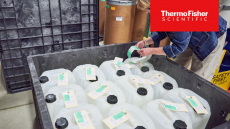Exploring sleep apnea solutions: Skye and Beacon's innovative obesity trial collaboration

As Skye embarks on their CBeyond phase 2 clinical trial, we explore the motivation, methodology, and expected outcomes of incorporating Beacon’s advanced sleep monitoring technology into their research. We also discuss the broader implications of this partnership and the potential for nimacimab to transform the treatment landscape for obesity and OSA.
Can you provide more details on the collaboration between Skye Bioscience and Beacon Biosignals?
Since obesity is a significant risk factor for obstructive sleep apnea (OSA), which affects up to 40 million Americans, Skye and Beacon saw an opportunity to work together to evaluate the potential of nimacimab to reduce detrimental sleep disturbances for patients enrolled in Skye’s upcoming phase 2 clinical trial. The addition of quantitative sleep-related endpoints in the trial aims to establish a broader view of the potential therapeutic benefits of nimacimab, given the linkage between metabolic conditions, sleep disturbances, and neurocognitive function.
The trial features exploratory endpoints measuring sleep quality using the FDA-cleared Dreem 3S EEG headband and AI-powered analytics platform. This enables the collection of clinically validated sleep assessments from patients in their own homes. Each trial participant will also use an oxygen saturation ring. Together, the devices will allow Beacon and Skye to evaluate sleep patterns, hypoxic events, and sleep disturbances as part of a 40-patient sub-study.
What motivated Skye Bioscience to incorporate Beacon’s SleepStageML software and Dreem Headband into your phase 2 obesity trial?
Obesity is associated with multiple comorbidities, including OSA. Apart from the potential to develop drugs with multiple physiological benefits, drug developers have recognized that validating effects on certain comorbid conditions may enhance the potential for their drug to achieve approval by payors for reimbursement. Related specifically to OSA, recent data showed that weight loss associated with tirzepatide leads to improvement in sleep apnea. Skye sees the opportunity to include an assessment of sleep quality as an efficient opportunity to achieve a first assessment of the possible effects of nimacimab on a comorbid condition alongside the primary assessment of weight loss. This positions Skye to be one of the first biotech companies to evaluate OSA in a phase 2 trial treating patients with obesity. The motivation behind choosing Beacon’s technology is that its at-home EEG platform will be convenient for patients and allow for a more comprehensive assessment of nimacimab's therapeutic effects on sleep quality early in the drug’s development.
How does Skye Bioscience plan to evaluate the impact of nimacimab on sleep quality and apnea in the trial participants?
Beacon’s FDA-cleared Dreem Headband will be used in a subset of 40 patients to collect sleep data and assess validated sleep endpoints. Multi-night data will be collected following screening and in weeks 13, 26, and the follow-up period. By integrating Beacon’s advanced sleep monitoring technology, the trial will assess improvements in sleep patterns and apnea events, such as sleep efficiency and the apnea-hypopnea index (AHI).
Can you elaborate on the potential relationship between obesity, obstructive sleep apnea (OSA), and how nimacimab may address these issues?
In obesity, fat mass is inappropriately elevated by physiological, lifestyle, and environmental factors, with certain processes being detrimentally altered long-term, leading to comorbid conditions like OSA. Addressing obesity and conditions such as OSA requires reversing the underlying physiology that leads to these negative outcomes. Nimacimab is a peripherally restricted cannabinoid receptor 1 (CB1)-inhibiting antibody. CB1 impacts elements of metabolic activity directly involved in modulating energy storage and use. Nimacimab may help patients with this sleep disturbance in the future through better treatment and management of their obesity.
What are the expected outcomes or key metrics that you hope to observe from this study involving EEG sleep data?
The addition of quantitative sleep-related endpoints aims to establish a comprehensive view of the therapeutic benefits of nimacimab, given the linkage between metabolic conditions, disturbed sleep, and neurocognitive function. By integrating Beacon's advanced sleep monitoring technology, our phase 2 trial will assess and quantify improvements in sleep patterns and apnea events, such as sleep efficiency and the apnea-hypopnea index.
How does this collaboration with Beacon Biosignals fit into Skye’s broader strategy for developing obesity treatments?
We aim to enhance our understanding of nimacimab's impact on our target patient population. By leveraging Beacon’s technology to monitor sleep quality and apnea, we have an opportunity to assess the potential benefits of nimacimab beyond weight loss. This collaboration represents a step in our commitment to addressing the complexities of obesity and developing effective treatments.
What were the main highlights from the “Metabolic Rewiring with CB1 Inhibition” event, and how do they relate to this new trial?
In addition to announcing our collaboration with Beacon, key opinion leaders provided an overview of nimacimab’s CB1 inhibition mechanism, earlier clinical readouts, and its potential for treating metabolic disease. We also presented our development plans for nimacimab, including the trial design for our upcoming phase 2 study.
The previous results included strong brain exclusion in preclinical studies, with no neuropsychiatric side effects reported. In the phase 1 study, nimacimab was found to be safe and well-tolerated, with no neuropsychiatric side effects, a low rate of treatment-emergent adverse events, no drug-related treatment discontinuation, and a very low level of gastrointestinal issues.
Nimacimab’s potential mechanism within the broader treatment landscape in obesity was also discussed. By targeting fat mass, CB1 inhibition preserves muscle mass more efficiently than alternative approaches. Additionally, CB1 blockade in peripheral tissues enhances insulin and leptin sensitivity, reduces adiposity and caloric intake, and increases energy expenditure, complementing incretin mimetics for additive therapeutic effects. Nimacimab, as a complement to standard care, may help better address obesity and comorbidities such as OSA. With improved safety and GI tolerability, nimacimab may enable longer-term treatment and provide a better overall quality of weight loss.
Our phase 2 study aims to assess the efficacy, safety, and tolerability of nimacimab alone and in combination with Wegovy (semaglutide) in patients with obesity. Screening for the study is expected to begin in August 2024, initiating across 18 sites in the U.S., with interim and topline data anticipated in Q2 and Q4 2025, respectively.
Lastly, we outlined our rapid development plans for nimacimab while continuously identifying opportunities to enhance its value through ongoing preclinical R&D and collaborations with academic institutions.
We encourage everyone to listen to the “Metabolic Rewiring with CB1 Inhibition” event, available on our website.
What challenges do you foresee in integrating sleep data collection with your ongoing clinical research, and how do you plan to address them?
We do not expect challenges in integrating sleep data collection using Beacon’s technology. Beacon has significant experience integrating the Dreem Headband into multiple clinical trial settings. Moreover, their at-home technology allows for convenient and seamless data collection, which is evaluated and scored by Beacon’s algorithms and shared with Skye’s data management team.
Can you discuss any preliminary feedback or observations from using the Dreem Headband and SleepStageML software in clinical settings?
To obtain its clearance, Dreem 3S's performance was evaluated in a clinical setting on multiple measures: performance compared to lab PSG, EEG data quality, and device usability in the home setting. This showed that the device could be successfully used and was well-tolerated by study subjects.
The Dreem Headband has been used to collect over 2 million nights of data in 30+ countries across 10+ pharma and biotech companies and 350+ academic labs. It has been used in 36 publicly listed clinical trials, with pharma-sponsored trials completed or underway in the US, UK, Germany, France, Spain, Australia, and Singapore, with contracting in process for additional countries.
How will the data collected from the Dreem Headband influence the future development and testing of nimacimab?
The data collected from the Dreem Headband will provide us with initial insight into the possible effects of nimacimab on sleep quality as a result of weight loss. By providing continuous clinically validated assessments of sleep disturbance-related parameters, the Dreem Headband helps us identify patterns and trends in patient responses. This insight may allow us to better target patient subgroups and optimize treatment regimens to enhance the benefits of nimacimab for patients with OSA in future clinical trials.


























